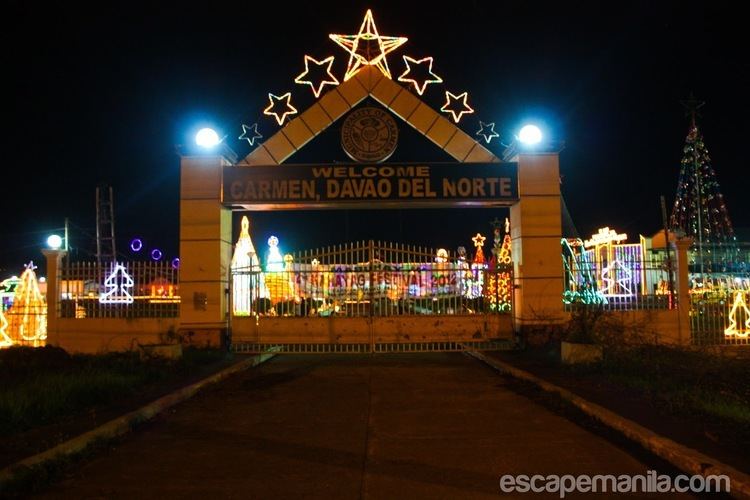Time zone PHT (UTC+8) Municipalities 8 | Founded May 8, 1967 Area rank 39th out of 81 Area 3,427 km² | |
 | ||
Points of interest Monfort Bat Sanctuary, Canibad Beach, Babu Santa Beach Re, Pearl Farm, Kaputian Beach Destinations | ||
Infomercial on tourism of davao del norte jma um tagum college
Davao del Norte (Cebuano: Amihanang Dabaw, Filipino: Hilagang Dabaw), is a province in the Philippines located in the Davao Region in Mindanao. Its capital is Tagum City. Davao del Norte also includes Samal Island to the south in the Davao Gulf.
Contents
- Infomercial on tourism of davao del norte jma um tagum college
- Map of Davao del Norte Philippines
- Tagum city davao del norte philippines
- History
- Geography
- Administrative divisions
- Demographics
- Indigenous groups
- Economy
- References
Map of Davao del Norte, Philippines
Before 1967, the five provinces—Davao del Norte, Davao Oriental, Davao del Sur, Davao Occidental and Compostela Valley—were administered as a single province named Davao. The Davao Region is coterminous with this former province.
Davao del Norte is also known as "the banana capital of the Philippines."
Tagum city davao del norte philippines
History
Davao del Norte and Compostela Valley, together with Davao Oriental, Davao Occidental and Davao del Sur used to be a whole province simply known as Davao. This original province was split into three: Davao del Norte, Davao Oriental, and Davao del Sur when Republic Act No. 4867 (authored by Representative Lorenzo S. Sarmiento, Sr.) was signed into law on May 8, 1967 by President Ferdinand Marcos.
Davao del Norte originally comprised thirteen municipalities: Asuncion, Babak (now in Samal City), Compostela, Kapalong, Mabini, Mawab, Monkayo, Nabunturan, Panabo, Pantukan, Samal, Santo Tomas and Tagum. On May 6, 1970, six more municipalities were created: Carmen, Kaputian (now in Samal City), Maco, Montevista, New Bataan, and New Corella.
The passage of Republic Act No. 6430 on June 17, 1972 changed the name of the province from Davao del Norte to Davao.
By 1996, Davao had a total of twenty-two municipalities with the creation of San Vicente (now Laak) in 1979, Maragusan in 1988, and Talaingod in 1991.
On January 31, 1998, President Fidel V. Ramos signed Republic Act No. 8470, which split the province into two, creating the province of Compostela Valley. In the meantime, Davao was renamed back to Davao del Norte. Together with the creation of the new province, two cities and one municipality were created: the municipality of Tagum, capital of Davao del Norte, was converted into a city (R.A. 8472); Samal, Babak, and Kaputian were joined into the city of Samal (R.A. 8471); and the municipality of Braulio E. Dujali was created out of several barangays in Panabo and Carmen (R.A. 8473). The province then had 8 municipalities and 2 cities.
Republic Act No. 9015, signed into law on March 5, 2001 by President Gloria Macapagal-Arroyo, converted the municipality of Panabo into a city. Republic Act No. 9265, approved on March 15, 2004 created the municipality of San Isidro from Asuncion and Kapalong.
Geography
Davao del Norte covers a total area of 3,426.97 square kilometres (1,323.16 sq mi) occupying the north-central section section of the Davao Region. The province borders Agusan del Sur to the north, Bukidnon to the west, Compostela Valley to the east, and Davao City to the south.
Samal City is the only municipality or city in the province not situated on Mindanao island. The city covers the entire Samal and Talikud Islands within the Davao Gulf.
The Leonard Kniaseff volcano is located within the province.
Administrative divisions
Davao del Norte comprises 8 municipalities and 3 cities.
Demographics
Davao del Norte had a population of 1,016,332 in the 2015 census. The population density was 297/km2 (768/sq mi). Main languages spoken are Cebuano and Davawenyo. English and Filipino are also widely spoken.
Indigenous groups
Talaingod is the home of many indigenous groups in Davao del Norte. Most of them are Lumads and Aetas.
Economy
Davao del Norte is a primarily agricultural, but also engages in mining, forestry, and commercial fishing.
The principal crops of the province include rice, maize, banana, coconut, abacá, ramie, coffee, and a variety of fruit and root crops. Davao del Norte is the country's leading producer of bananas, with many plantations run by multinationals Dole and Del Monte, and local producers such as Lapanday, TADECO, and Marsman. Davao del Norte is also one of Mindanao's leading producer of rice.
Davao Gulf, to the south of the province, provides a living for many fishermen. Some of the fish products include brackish water milkfish, tilapia, shrimp, and crab; and freshwater catfish and tilapia.
Davao del Norte is a major producer of gold, and its mining resources include silica, silver, copper and elemental sulfur. Small-scale gold mining activities thrive in several areas. There are also numerous active quarries of commercial quantities of gravel, sand, and pebbles for construction.
Tourism is also a major part of the economy of Davao del Norte. There are a lot of beaches on Samal Island, the most famous of which is Pearl Farm Beach Resort. Banana Beach Resort is the most famous beach outside of Samal Island.
Commerce is also a major part of the economy of Davao del Norte. There are lot of shopping malls in Tagum City.
